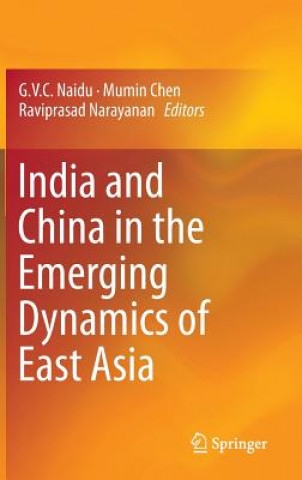
Doručení
Nákupní rádce





Nehodí se? Vůbec nevadí! U nás můžete do 30 dní vrátit
 Dárkový poukaz
V libovolné hodnotě
Dárkový poukaz
V libovolné hodnotě
S dárkovým poukazem nešlápnete vedle. Obdarovaný si za dárkový poukaz může vybrat cokoliv z naší nabídky.
India and China in the Emerging Dynamics of East Asia
 Angličtina
Angličtina
 304 b
304 b
30 dní na vrácení zboží
Mohlo by vás také zajímat


Though considerable research literature is now available on China India relations, most of it still follows a conventional narrative, viewing the relationship through the narrow conflictual prism limited to South Asia than in the new, larger perspective, especially in the context of emerging East Asian dynamics. This book offers comprehensive analyses of some of these issues in papers addressing two broad themes. One, significant trends in the relationship between China and India on a range of issues, including economic development models, their military strategies, and the boundary dispute; and two, how others are responding to the rise of India and China and their impact on East Asia. Together, the chapters constitute a comprehensive study on both China India relations and their concurrent rise, including a variety of perspectives and methodologies. Written by some of the top experts on the subject from India, China, Japan, and Taiwan and covering a broad range of issues, the book will generate considerable interest in understanding this relatively neglected dimension of today s East Asia.§§Even until the late 1990s, most scholars hardly paid attention to the likely rivalry or competition between India and China in East Asia. Although opinions had been divided, China s march to dominate the region was nearly unchallenged with the accretion of huge economic and military power. With the US deeply embroiled in wars in Iraq and Afghanistan, Japan mired in economic stagnation, and India still trying to wriggle out of decades of red tape, political lethargy and a reticence to look beyond its immediate vicinity, it was surmised that East Asia would have no choice but to accept the new reality of a China-led regional hierarchy. Which means, to follow the historical trend, a new order would come about, replacing the older one.§§But things began to change, with India unfolding the second phase of its Look East policy in the early 2000s with renewed vigour and commitment once it became clear that it did not have too many choices to better its economic prospects and play a commensurate role. By the end of the first decade of the twenty-first century, Washington had announced its determination that it was back in Asia , which was quickly followed by the launch of the pivot or rebalance strategy. Not to be left behind, Japan, under the conservative governments especially of Taro Aso and Shinzo Abe (who has amazingly staged a successful comeback to the helm), is determined to unveil a new self that is not only willing to redefine its regional role, but also embark on a bold new security policy aimed at greater strategic autonomy. New Delhi has also stepped up its involvement by not simply looking, but actively engaging the East through a comprehensive, multifaceted policy covering economic, political and strategic aspects. Amid this, the Association of South-East Asian Nations (ASEAN) too has upped the ante by forcefully pushing across a robust role for itself and for the regional multilateralism led by it. To compound the security environment further, the disputes over islands that had long remained dormant in the East and South China Seas have emerged as highly contentious, threatening to disrupt regional peace and stability. A major issue that analysts and policy makers alike are trying to grapple with is the rise of China and its increasingly assertive attitude both politically and militarily.§§As a result, East Asian security is becoming all the more complex, even while the regional scene is characterised by an unprecedented economic dynamism. Indeed, it is extraordinary that virtually the entire East Asian region is on the rise. This phenomenon undoubtedly will have huge implications not merely for the region but for the rest of the world and, hence, the stakes are simply too high. Yet, the current transitory phase that the region is experiencing is fraught with serious problems; meanwhile, uncertainties remain in the nature of
Informace o knize
 Angličtina
Angličtina
Kategorie




 Jak nakupovat
Jak nakupovat























